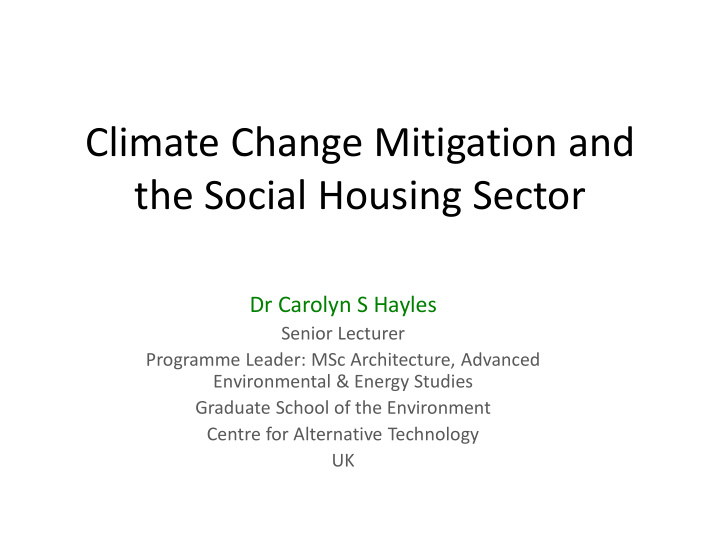



Climate Change Mitigation and the Social Housing Sector Dr Carolyn S Hayles Senior Lecturer Programme Leader: MSc Architecture, Advanced Environmental & Energy Studies Graduate School of the Environment Centre for Alternative Technology UK
Premise for research To understand… • Barriers and motivators surrounding ‘sustainable’ behaviour in the home • How tenants responds to design and technology aimed at reducing carbon emissions in order to create durable change
What? The project Funded by the Northern Ireland Housing Executive (NIHE) in partnership with Queen’s University Belfast (QUB) • Investigate social housing tenants’ awareness and perceptions of climate change and low carbon ‘sustainable’ living and their current behaviours • Work with social housing professionals to establish their understanding • Determine the challenges and opportunities for achieving sustainable low/zero carbon housing
Why? Rationale: Social Housing Targets • UK Government’s aim is to reduce carbon emission by 60% by 2050 • Building and construction sector have been targeted • By 2016 all new build homes are to be zero carbon – Net of zero carbon over the year inclusive of all energy use in the home • very low carbon or renewable energy • high levels of insulation
Why? Rationale: The Code for Sustainable Homes (CSH) • Established in 2007 • National Standard for the sustainable design and construction of new homes • Measures the sustainability of a new home against nine categories of sustainable design, rating the 'whole home' as a complete package • Minimum standards for energy and water use at each level • Uses a 1 to 6 rating system to communicate the overall sustainability performance of a new home
When? Nov 2009 – Dec 2010 Who? 53 NIHE tenant families (future tenants of Code 4-6 housing) • Cross section of industry stakeholders • How? Decision Support Framework (Hayles & Dean, 2010; 2011) 1. Awareness 2. Behaviour 3. Intervention 4. Action
Decision Support Framework Recommendations from previous research • Map behaviours as a precursor to achieving behavioural change • Consider technological interventions, end users and the relationship between them • Study of motivations, values and self efficacy • Take into account social norms and practices that underpin the behaviour of the individual or community • Include both top down and bottom up processes, encompassing stakeholders and end users
Social Housing tenants: Awareness and Behaviours • Scene Setting • Energy use in the home • Energy strategies • Food • Water • Consumer Behaviour • Demographics
Results 1 Summary of Key Perceptions: Climate Change
Results 2 Summary of Key Perceptions: Energy
Results 3 Summary of Key Behaviours: Energy Use in the Home
Results 4 Summary of Key Behaviours: Water Use in the Home
Figure 1: Example ecological footprint results
Intervention: Focus Group The tenant focus groups aimed to further explore end users perceptions and awareness of sustainable living through a series of activities: • Awareness of media campaigns to encourage sustainable behaviours • Perceptions of sustainable housing and design features • Behavioural changes required to live in such a home and their feelings towards such change
Summary from Tenant Focus Group
Summary from Tenant Focus Group continued….
Action • Feedback to stakeholders • Supported transition to new ‘sustainable’ home • Post occupancy behaviour evaluation
Stakeholders Interviews Scene setting • Approaches to sustainable design and construction • Perceptions of tenants’ requirements • Appropriateness of current design guides • Focus Groups Feedback on stakeholders perceptions and awareness of • sustainable behaviours Exploration of design strategies • Discussion on challenges and barriers to change • Feedback on tenant behaviours and how to further encourage and • support sustainable behaviours in conjunction with design and technology
Conclusions • Tenants were aware of climate change and willing to make changes to reduce their energy consumption • Many behaviours are already in place • More needs to be done to support tenants’ willingness to change • Stakeholders suggest that the industry is neither ready nor willing to embrace change and identified a number of barriers • More needs to be done to support the industry to drive through innovation and meet the challenges of CSH and Zero Carbon
Recommendations • When considering sustainable housing, appropriate design and technology are not enough, it is also necessary to foster sustainable behaviour • Occupant engagement is therefore essential if the UK Government’s zero carbon targets are to be met • Tenants in this study have demonstrated a willingness to engage • The industry now needs to harness this willingness and work with tenants to develop sustainable strategies for low/zero carbon living
Thank You Dr Carolyn S Hayles carolyn.hayles@cat.org.uk
Recommend
More recommend